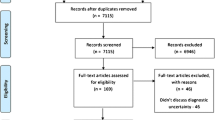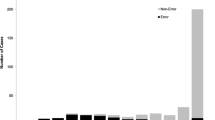Abstract
INTERNIST-1 and its successor Quick Medical Reference (QMR), are computer programs which utilize an extensive knowledge base of diseases in internal medicine to assist clinicians in the task of diagnosis. The provision of medical care, in general, and the utilization of the diagnostic laboratory, in particular, are known to exhibit wide variation among physicians. A neglected reason for some of this variation may be the degree of diagnostic uncertainty accompanying each patient case. We propose that computer programs like QMR may decrease some of this variability by providing more information to the physician, and we discuss a methodology for testing this proposal.
Access this chapter
Tax calculation will be finalised at checkout
Purchases are for personal use only
Preview
Unable to display preview. Download preview PDF.
Similar content being viewed by others
References
Miller RA, Pople HE, Myers JD: INTERNIST-1, An experimental computer-based diagnostic consultant for general internal medicine, N Engl J Med, 1982, 307: 468–476.
Miller RA, McNeil MA, Challinor, SM, et al., The INTERNIST-1/Quick Medical Reference Project - Status Report, West J Med, 1986, 145: 816–822.
Bankowitz RA, McNeil MA, Challinor, SM et al., A Computer-Assisted Medical Diagnostic Consultation Service: Implementation and prospective evaluation of a prototype, Ann Intern Med, 1989, 110: 824–832.
Bankowitz RA, McNeil MA, Challinor, SM, Miller RA, Effect of a computer-assisted general medicine diagnostic consultation service on house staff diagnostic strategy, Meth Inform Med, 1989, 28: 352–356.
Schroeder SA, Myers LP, McPhee SJ, Use of Laboratory tests and pharmaceuticals: variation among physicians and effect of cost audit on subsequent care, JAMA 1984; 252: 225–30.
Noren J, Frazier T, Altman I and DeLozier J. Ambulatory medical care: A comparison on internists and family-general practitioners. N Engl J Med 1980; 302: 11–16.
Chassin MR, Kosecoff J, et al. Does inappropriate use explain geographic variations in the use of health care services? N Engl J Med 1986; 314: 285–90.
Wennberg JE, Freeman JL and Culp WJ. Are hospital services rationed in New Haven or over-utilized in Boston?. Lancet May 23, 1987; 1185–1189.
Wennberg JE, Gittleshon A, Small area variations in health care delivery. Science 1973; 18: 1102–1108.
Roos NP, Flowerdew G, Wajda A, et al., Variations in physicians’ hospitalization practices: A population-based study in Manitoba, Canada. American Journal of Public Health 1986:; 76 (1): 45–51.
Lewis CE. Variation in the incidence of surgery. N Engl J Med 1969; 281: 880–884.
McPherson K, Wennberg JE, Hovind OB, et al. Small-area variation in the use of common surgical procedures: an international comparison of New England, England and Norway. N Engl J Med 1982; 307: 1310–1314.
Wennberg JE, Mulley AG, Hanley D, et al. An assessment of prostatectomy for benign urinary tract obstruction. JAMA 1988; 259: 3027–3030.
Manu P, and Schwartz SE, Patterns of diagnostic testing in the academic setting: The influence of medical attending; subspecialty training. Soc Sci Med 1983; 17: 1339–42.
Eisenberg JM, Nicklin D, Use of diagnostic services by physicians in community practice. Med Care 1981; 19: 297–309.
Goldfarb MG, Hornbrook MC, Higgins CS, Determinants of hospital use: A cross-diagnostic analysis. Med Care 1983; 21: 48–66.
Bryant GD and Norman GR. Expressions of probability: Words and numbers. N Engl J Med 1980; 302: 411.
Pauker SG, Kassirer JP. Decision Analysis. N Engl J Med 1987; 316: 250–258.
Author information
Authors and Affiliations
Editor information
Editors and Affiliations
Rights and permissions
Copyright information
© 1991 Springer-Verlag Berlin Heidelberg
About this paper
Cite this paper
Bankowitz, R.A. (1991). The Role of Diagnostic Uncertainty in Health Care Outcomes and its Potential for Modification with Decision Support. In: Adlassnig, KP., Grabner, G., Bengtsson, S., Hansen, R. (eds) Medical Informatics Europe 1991. Lecture Notes in Medical Informatics, vol 45. Springer, Berlin, Heidelberg. https://doi.org/10.1007/978-3-642-93503-9_71
Download citation
DOI: https://doi.org/10.1007/978-3-642-93503-9_71
Publisher Name: Springer, Berlin, Heidelberg
Print ISBN: 978-3-540-54392-3
Online ISBN: 978-3-642-93503-9
eBook Packages: Springer Book Archive




